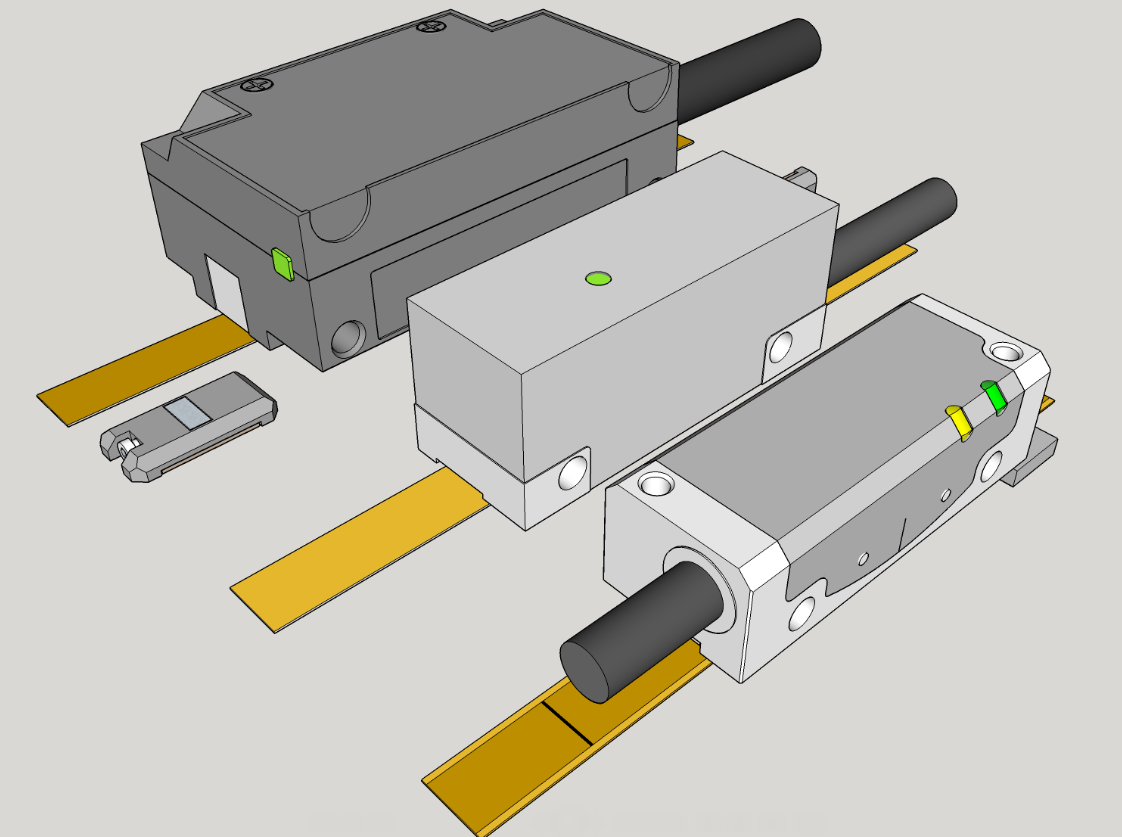|
Ronchi Linear Diffraction Grating
A Ronchi ruling, Ronchi grating, or Ronchi mask, named after the Italian physicist Vasco Ronchi, is a constant-interval bar and space square-wave optical target or mask. The design produces a precisely patterned light source by reflection or illumination, or a stop pattern by transmission, with precise uniformity, spatial frequency, sharp edge definition, and high contrast ratio. Manufacturing Ronchi rulings are typically manufactured through photolithographic deposition of metallic chromium on a substrate, which yields a precise, nearly 100% contrast pattern. For a reflective or illuminated type, dark stripes are printed on a diffusely reflecting or translucent substrate, such as a square of white ceramic material or opal glass. For a transmissive type, opaque stripes are printed on a transparent glass substrate. A transmissive type may be readily modified to act as an illuminated type by stacking a reflective object behind it. Applications A test target in the Ronchi patte ... [...More Info...] [...Related Items...] OR: [Wikipedia] [Google] [Baidu] |
Vasco Ronchi
Vasco Ronchi (; December 19, 1897 – October 31, 1988) was an Italian physicist known for his work in optics. He was born on 19 December 1897 in Florence, Italy. Along with Enrico Fermi, he was a student of Luigi Puccianti. He studied at the Faculty of Physics of the University of Pisa from 1915 to 1919. In 1922 Ronchi published work describing testing methods for optics using simple equipment. The Ronchi test is widely used in amateur telescope making. The Ronchi ruling also bears his name. He served numerous terms as the President of the 'Union Internationale d'Histoire des Sciences' within the UNESCO The United Nations Educational, Scientific and Cultural Organization is a specialized agency of the United Nations (UN) aimed at promoting world peace and security through international cooperation in education, arts, sciences and culture. It .... Ronchi authored 900 papers and 30 books. External links Ronchi, Vasco (1897-1988) 1897 births 1988 deaths 20th-centu ... [...More Info...] [...Related Items...] OR: [Wikipedia] [Google] [Baidu] |
Square Wave
A square wave is a non-sinusoidal periodic waveform in which the amplitude alternates at a steady frequency between fixed minimum and maximum values, with the same duration at minimum and maximum. In an ideal square wave, the transitions between minimum and maximum are instantaneous. The square wave is a special case of a pulse wave which allows arbitrary durations at minimum and maximum amplitudes. The ratio of the high period to the total period of a pulse wave is called the duty cycle. A true square wave has a 50% duty cycle (equal high and low periods). Square waves are often encountered in electronics and signal processing, particularly digital electronics and digital signal processing. Its stochastic counterpart is a two-state trajectory. Origin and uses Square waves are universally encountered in digital switching circuits and are naturally generated by binary (two-level) logic devices. Square waves are typically generated by metal–oxide–semiconductor ... [...More Info...] [...Related Items...] OR: [Wikipedia] [Google] [Baidu] |
Photolithography
In integrated circuit manufacturing, photolithography or optical lithography is a general term used for techniques that use light to produce minutely patterned thin films of suitable materials over a substrate, such as a silicon wafer (electronics), wafer, to protect selected areas of it during subsequent etching, Chemical vapor deposition, deposition, or Ion implantation, implantation operations. Typically, ultraviolet light is used to transfer a geometry, geometric design from an photomask, optical mask to a photosensitivity, light-sensitive chemical (photoresist) coated on the substrate. The photoresist either breaks down or hardens where it is exposed to light. The patterned film is then created by removing the softer parts of the coating with appropriate solvents. Conventional photoresists typically consists of three components: resin, sensitizer, and solvent. Photolithography processes can be classified according to the type of light used, such as ultraviolet, deep ultrav ... [...More Info...] [...Related Items...] OR: [Wikipedia] [Google] [Baidu] |
Chromium
Chromium is a chemical element with the symbol Cr and atomic number 24. It is the first element in group 6. It is a steely-grey, lustrous, hard, and brittle transition metal. Chromium metal is valued for its high corrosion resistance and hardness. A major development in steel production was the discovery that steel could be made highly resistant to corrosion and discoloration by adding metallic chromium to form stainless steel. Stainless steel and chrome plating (electroplating with chromium) together comprise 85% of the commercial use. Chromium is also greatly valued as a metal that is able to be highly polished while resisting tarnishing. Polished chromium reflects almost 70% of the visible spectrum, and almost 90% of infrared light. The name of the element is derived from the Greek word χρῶμα, ''chrōma'', meaning color, because many chromium compounds are intensely colored. Industrial production of chromium proceeds from chromite ore (mostly FeCr2O4) to pro ... [...More Info...] [...Related Items...] OR: [Wikipedia] [Google] [Baidu] |
Opal Glass
Milk glass is an opaque or translucent, milk white or colored glass that can be blown or pressed into a wide variety of shapes. First made in Venice in the 16th century, colors include blue, pink, yellow, brown, black, and white. Principle Milk glass contains dispersion of particles with refractive index significantly different from the glass matrix, which scatter light by the Tyndall scattering mechanism. The size distribution and density of the particles control the overall effect, which may range from mild opalization to opaque white. Some glasses are somewhat more blue from the side, and somewhat red-orange in pass-through light. The particles are produced via addition of opacifiers to the melt. Some opacifiers can be insoluble and only dispersed in the melt. Others are added as precursors and react in the melt, or dissolve in the molten glass and then precipitate as crystals on cooling; this is similar to color production in striking glasses, but the particles are m ... [...More Info...] [...Related Items...] OR: [Wikipedia] [Google] [Baidu] |
Ronchi Test
In optical testing a Ronchi test is a method of determining the surface shape ( figure) of a mirror used in telescopes and other optical devices. Description In 1923 Italian physicist Vasco Ronchi published a description of the eponymous Ronchi test, which is a variation of the Foucault knife-edge test and which uses simple equipment to test the quality of optics, especially concave mirrors.Masud Mansuripur (July 1997) "The Ronchi test," ''Optics & Photonics News'', vol. 8, pages 42-46. Available on-line at: http://www.mmresearch.com/articles/article1/index.htm . A "Ronchi tester" consists of: *A light source *A Diffuser (optics), diffuser *A Ronchi grating A Ronchi grating consists of alternate dark and clear stripes. One design is a small frame with several evenly spaced fine wires attached. Light is emitted through the Ronchi grating (or a single slit), reflected by the mirror being tested, then passes through the Ronchi grating again and is observed by the person doing t ... [...More Info...] [...Related Items...] OR: [Wikipedia] [Google] [Baidu] |
Linear Encoder
A linear encoder is a sensor, transducer or readhead paired with a scale that encodes position. The sensor reads the scale in order to convert the encoded position into an analog or digital signal, which can then be decoded into position by a digital readout (DRO) or motion controller. The encoder can be either ''incremental'' or ''absolute.'' In an incremental system, position is determined by motion over time; in contrast, in an absolute system, motion is determined by position over time. Linear encoder technologies include optical, magnetic, inductive, capacitive and eddy current. Optical technologies include shadow, self imaging and interferometric. Linear encoders are used in metrology instruments, motion systems, inkjet printers and high precision machining tools ranging from digital calipers and coordinate measuring machines to stages, CNC mills, manufacturing gantry tables and semiconductor steppers. Physical principle Linear encoders are transducers that exploit many d ... [...More Info...] [...Related Items...] OR: [Wikipedia] [Google] [Baidu] |
Bahtinov Mask
The Bahtinov mask is a device used to focus small astronomical telescopes accurately. Although masks have long been used as focusing aids, the distinctive pattern was invented by Russian amateur astrophotographer Pavel Bahtinov (russian: Павел Бахтинов) in 2005. Precise focusing of telescopes and astrographs is critical to performing astrophotography. The telescope is pointed at a bright star, and a mask is placed in front of the telescope's objective (or in front of the aperture). The mask consists of three separate grids, positioned in such a way that the grids produce three angled diffraction spikes at the focal plane of the instrument for each bright image element. As the instrument's focus is changed, the central spike appears to move from one side of the star to the other. In reality, all three spikes move, but the central spike moves in the opposite direction to the two spikes forming the "X". Optimal focus is achieved when the middle spike is centered betwe ... [...More Info...] [...Related Items...] OR: [Wikipedia] [Google] [Baidu] |
1951 USAF Resolution Test Chart
A 1951 USAF resolution test chart is a microscopic optical resolution test device originally defined by the U.S. Air Force MIL-STD-150A standard of 1951. The design provides numerous small target shapes exhibiting a stepped assortment of precise spatial frequency specimens. It is widely used in optical engineering laboratory work to analyze and validate imaging systems such as microscopes, cameras and image scanners. The full standard pattern consists of 9 groups, with each group consisting of 6 elements; thus there are 54 target elements provided in the full series. Each element consists of three bars which form a minimal Ronchi ruling. These 54 elements are provided in a standardized series of logarithmic steps in the spatial frequency range from 0.250 to 912.3 line pairs per millimeter (lp/mm). The series of elements spans the range of resolution of the unaided eye, down to the diffraction limits of conventional light microscopy. Commercially produced devices typic ... [...More Info...] [...Related Items...] OR: [Wikipedia] [Google] [Baidu] |






